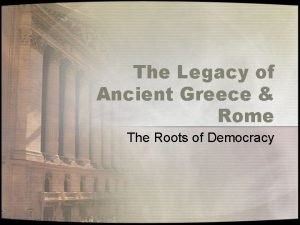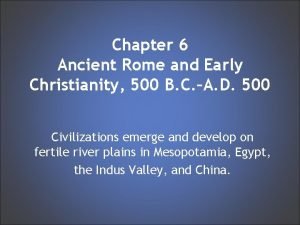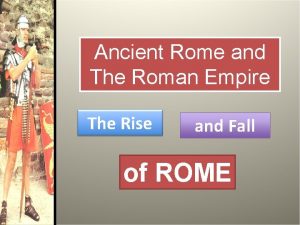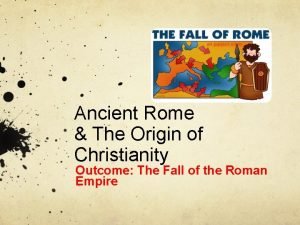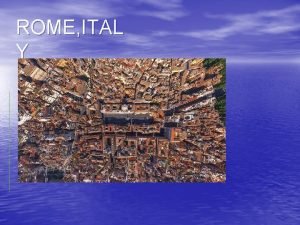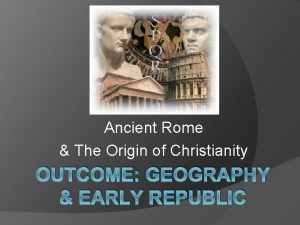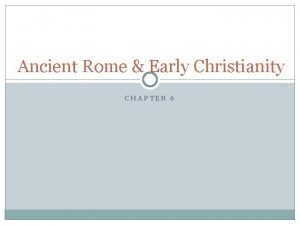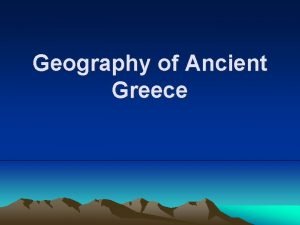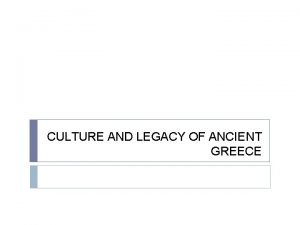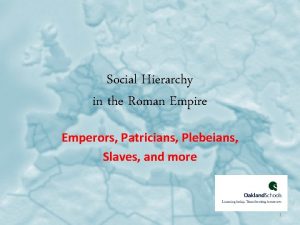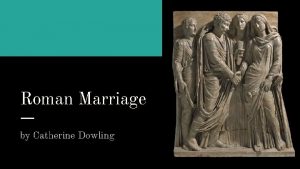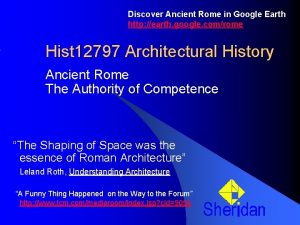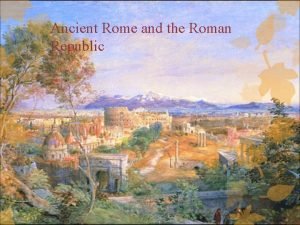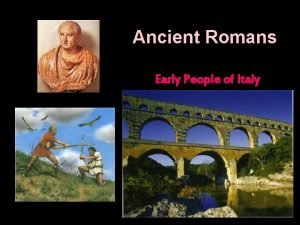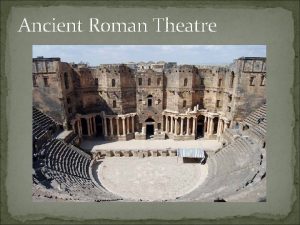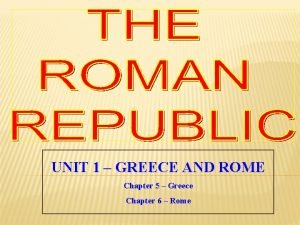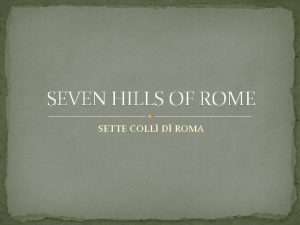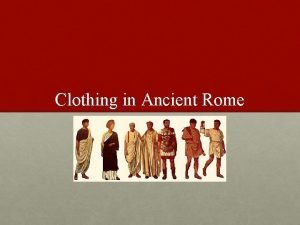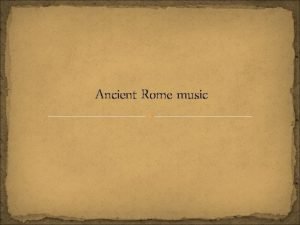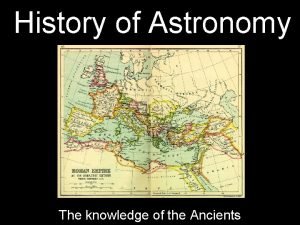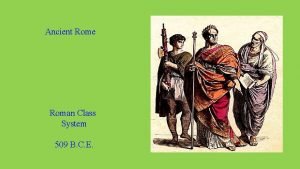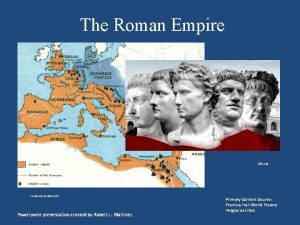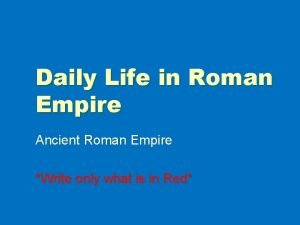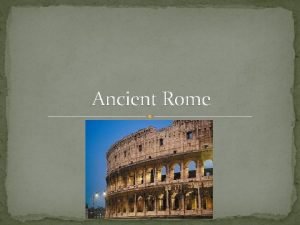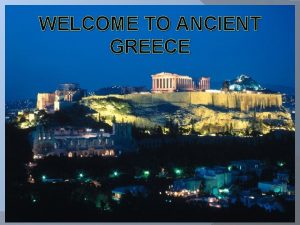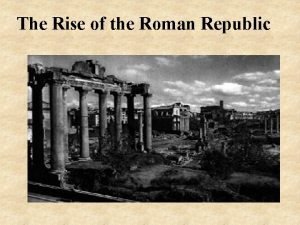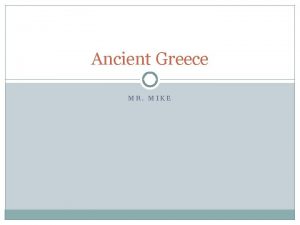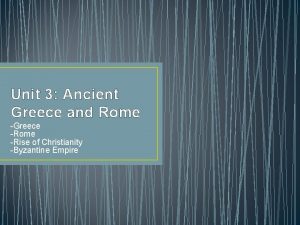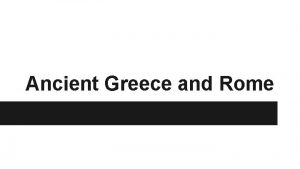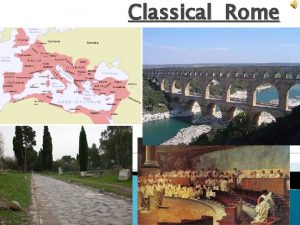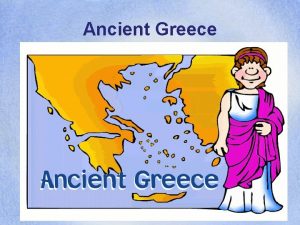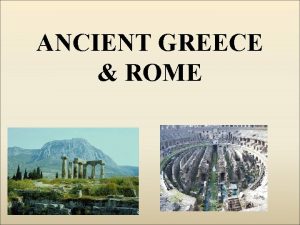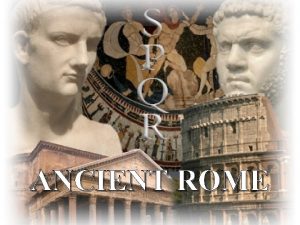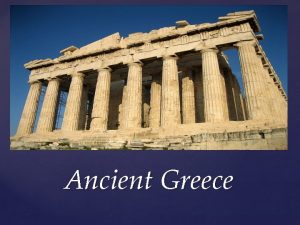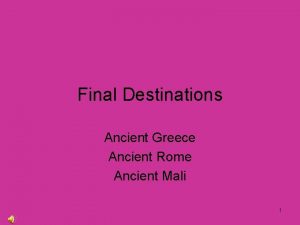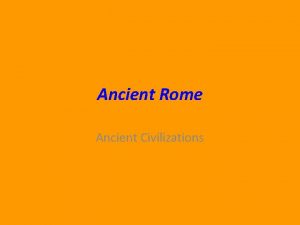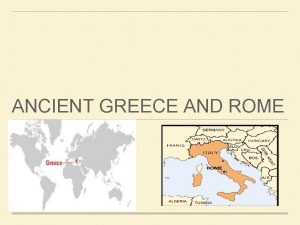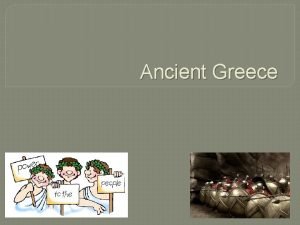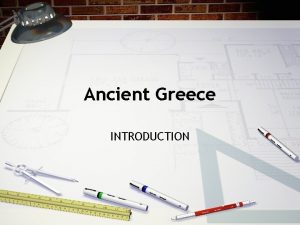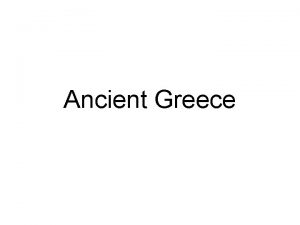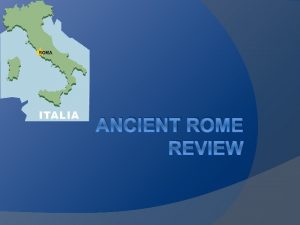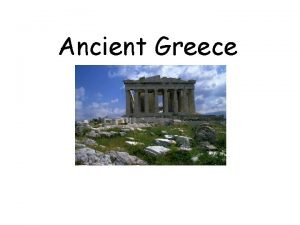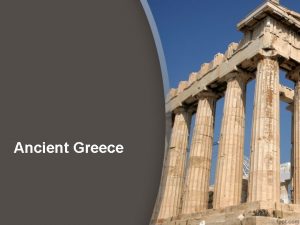Greece Rome How have Ancient Greece and Rome
































- Slides: 32

Greece & Rome How have Ancient Greece and Rome impacted modern society?

Greece: Geography • Located on the Aegean Sea next to the Mediterranean Sea. • Greece consists of many mountains, isolated valleys, and islands. § Greek civilization consisted of many City-States called Polis. • The only thing Greeks shared was religion and language.


The Greek City-State • The Polis was divided into two parts: the agora (marketplace) and the acropolis (marble temple). • Athens and Sparta were the two most powerful City-States.

Athens vs. Sparta • In Sparta—a warrior society emphasized military training with little else. Young boys began their training at a young age. • In Athens---the culture stressed education revolving around math, writing, and science, and art.

Direct Democracy • Pericles ran Athens during it’s Golden Age. He beautified the city, encouraged education, and spread direct democracy. • Direct Democracy – a large amount of male citizens actually took part in day to day voting.

Alexander the Great • From Macedonia, but conquers the Greeks. • Spread Greek (Hellenistic) culture all the way to India including: § Philosophy (Plato, Socrates, Aristotle) § Literature (Homer) § Art & Architecture (Theaters, Drama, & Art) § Science & Math (Hippocrates & Pythagoras)


Geography of Rome • Rome is located in the center of Italy, a peninsula located in the Mediterranean Sea. § Fertile land § Location helped trade

Rome built great stuff • Rome built great roads to travel on and aqueducts to bring water into the city. • Rome also built great stadiums and amphitheaters like the Coliseum for the entertainment of the people. • Romans also developed the use of the arch.


Rome was a Republic • A republic is a form of government where people elect representatives. • The United States has a representative government. We learned about this form of government from the Romans.

The Senate • The Senate led the Roman Empire. • They made the laws for the republic and were from the upperclass called Patricians. • Plebeians (farmers, merchants, artisans, etc. ) had little power.

Rome’s women got shafted • Rome might have had representative government, but not all people were represented. • Roman women were not allowed to vote. • Only men—who owned land were considered Roman citizens.

Roman Law and Rights • Roman laws, called the Twelve Tables, stressed fairness and common sense. • There was equal treatment under the law in Rome and people were considered innocent until proved guilty when accused of a crime. (Sound familiar? ) • We took much of our system of government from the Romans.

Roman Art • Mosaics were popular in Rome. A mosaic is a picture made out of small, colored tiles or pieces of glass. • The Romans also made great statues that looked like the real thing, even though they were made from stone.


Rome’s first emperor • Octavian is Rome’s first emperor. • He took the name Augustus Caesar. • Under his rule, Rome expanded and enjoyed a period of peace.

Pax Romana • Rome lived in peace for 200 years. • It was called the Pax Romana, the Peace of Rome. Unfortunately for Rome, the peace would not last.

Rome grew weak • Rome grew weak because it had grown too large. • Another reason Rome grew weak is that they had tax problems and couldn’t raise enough money to keep the roads from crumbling. • Slavery was also a problem in the empire. With so many slaves, the people did not need to work. • Internal problems that helped Rome’s downfall were corrupt generals, civil wars, and economic problems.

Barbarians at the gates • Romans called the people who destroyed Rome Barbarians. • Romans called anyone who didn’t speak Greek, even though the word barbarian actually means uncivilized, lacking in culture and violent. • The Roman Empire fell in 476 AD. • The eastern part of the empire would survive.

Byzantium • The eastern part of the Roman Empire became known as the Byzantine Empire or Byzantium.

Constantinople • Constantinople was named for emperor Constantine. • Constantine was important because he legalized Christianity in the empire. • Under Constantine’s rule, Christianity spread greatly. • He moved the capital of the empire from Rome to Constantinople.


Constantinople grows • Constantinople became a leading center of trade. • Trade helped the Byzantine Empire grow rich.

Justinian • Justinian was the greatest of the Byzantine emperors. • Justinian made many changes in the laws. • His laws were called The Code of Justinian. • Justinian also built many churches throughout the empire.

Disagreements between east and west • Most of the people in the Byzantine Empire were Christian, but the people in the west and the people in the east disagreed about how to worship God. • This led to a split in the Catholic Church. It was called a schism. • A schism is a split. The Roman Catholic Church had a schism, splitting in half.

Two churches • The church in the east was called Eastern Orthodox. • The church in the west was called Roman Catholic.

Patriarch • The leader of the church in Constantinople was called the Patriarch.

Pope • The leader of the church in Rome was called the Pope.

Constantinople is captured • The split in the church weakened the Byzantine Empire. • In 1453, the Ottoman Turks captured Constantinople and the Byzantine Empire came to an end.

The Byzantine Empire preserves great stuff • The Byzantine Empire preserved the art and literature of the Greeks and Romans. • Without the Byzantine, the world may have lost great treasures of the past.
 Greek philosophers who contributed in physical education
Greek philosophers who contributed in physical education The legacy of ancient greece and rome
The legacy of ancient greece and rome What is a myth
What is a myth The glory that was greece the grandeur that was rome
The glory that was greece the grandeur that was rome Chapter 6 ancient rome and early christianity
Chapter 6 ancient rome and early christianity Roman road
Roman road Ancient rome and the origins of christianity
Ancient rome and the origins of christianity Geography of rome
Geography of rome Ancient rome outcomes geography and early republic
Ancient rome outcomes geography and early republic Ancient rome and early christianity chapter 6
Ancient rome and early christianity chapter 6 Sparta greece map
Sparta greece map Culture or way of living station 1
Culture or way of living station 1 Babylon medo-persia, greece rome timeline
Babylon medo-persia, greece rome timeline Holy roman empire hierarchy
Holy roman empire hierarchy Dowry ancient rome
Dowry ancient rome Ancient google earth
Ancient google earth Ancient rome geography
Ancient rome geography The etruscans lived in the area known as _____.
The etruscans lived in the area known as _____. Ancient roman theatre history
Ancient roman theatre history Ancient rome tiber river
Ancient rome tiber river Seven hill roma
Seven hill roma Education in ancient rome
Education in ancient rome Clothing in ancient rome
Clothing in ancient rome Ancient rome dance
Ancient rome dance Ancient rome jeopardy
Ancient rome jeopardy Astronomy in ancient rome
Astronomy in ancient rome Ancient rome class system
Ancient rome class system Pbs ancient rome
Pbs ancient rome Roman empire family life
Roman empire family life Famous landmarks in rome
Famous landmarks in rome Patrician
Patrician How was tyranny government practiced in ancient greece
How was tyranny government practiced in ancient greece Patricians ancient rome
Patricians ancient rome

